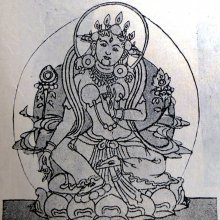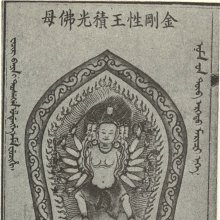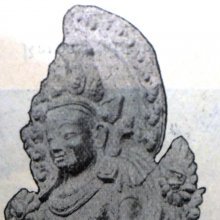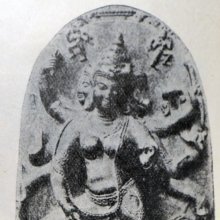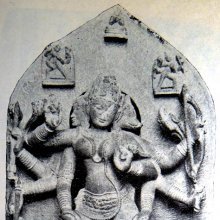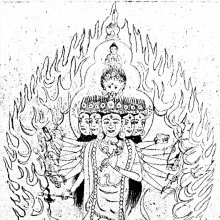Vajradhatvishvari, Vajradhātvīśvarī: 5 definitions
Introduction:
Vajradhatvishvari means something in Buddhism, Pali, Hinduism, Sanskrit. If you want to know the exact meaning, history, etymology or English translation of this term then check out the descriptions on this page. Add your comment or reference to a book if you want to contribute to this summary article.
The Sanskrit term Vajradhātvīśvarī can be transliterated into English as Vajradhatvisvari or Vajradhatvishvari, using the IAST transliteration scheme (?).
Images (photo gallery)
(+3 more images available)
In Buddhism
Tibetan Buddhism (Vajrayana or tantric Buddhism)
Source: archive.org: The Indian Buddhist Iconography1) Vajradhātviśvarī (वज्रधात्विश्वरी) or Vajradhātvīśvarīmārīcī is a variety of Mārīcī: one of the various emanations of Vairocana, as mentioned in the 5th-century Sādhanamālā (a collection of sādhana texts that contain detailed instructions for rituals).—Her Āsana is the ālīḍha; her Appearance is terrible; she has six faces and twelve arms.—When six-faced and twelve-armed, Mārīcī is invoked in three different forms and under three different names: Vajradhātvīśvarī Mārīcī. Uḍḍiyāna Mārīcī, and Vajravetālī. These three forms are classed together here because of their marked resemblance. They differ however in minor details and in respect of the weapons they carry in their hands.
Vajradhātvīśvarī is described in the Sādhanamālā as follows:—
[The features that are common to all the three may be summarised from the Sādhanas as follows. They are all endowed with six faces and twelve arms. The first five faces are respectively of red, blue, green, yellow and white colour. The face on the top is misshapen like that of a sow, and is blue in colour. All the three are said to reside in the womb of a Caitya; they stand in the ālīḍha attitude and bear the image of Vairocana on the crown. They present a terrifying spectacle with three eyes, protruding tongue, bare fangs, serpents for ornaments and garments of tiger-skin.
Vajradhātvīśvarī carries in her six right hands, 1. the sword, 2. the mūṣala, 3. the arrow, 4. the goad, 5. the vajra and 6. the paraśu, and in the six left 1. the noose, 2. the kapāla, 3. the Aśoka bough, 4. the severed head of Brahmā, 5. the bow and 6. the triśula.]
2) Vajradhātviśvarī (वज्रधात्विश्वरी) is the Śakti, or female counterpart (spiritual consort) of Ratnasambhava: one of the Dhyāni-Buddhas, according to Vajrayāna or Tantric Buddhism.—Her colour is yellow; and her symbol is the jewel.—Vajradhātvīśvarī, according to a statement in the Advayavajrasaṃgraha is the deity of the centre surrounded by the four Buddhaśaktis, Locanā, Tārā, Pāṇḍarā, and Māmakī. She is said to be the embodiment of the highest truth in Mahāyāna Buddhism which is nameddifferently as Tathatā, Sūnyatā, Prajñāpāramitā and so forth. Vajradhātvīśvarī thus can be taken as the spiritual consort of Ratnasambhava only, with the yellow colour and the jewel as symbol.
Source: OSU Press: Cakrasamvara SamadhiVajradhātvīśvarī (वज्रधात्वीश्वरी) is the name of a deity [i.e., oṃm vajradhātvīśvarī abhiṣiñcatu māṃ], according to the Cakrasaṃvara Samādhi [i.e., Cakrasamvara Meditation] ritual often performed in combination with the Cakrasaṃvara Samādhi, which refers to the primary pūjā and sādhanā practice of Newah Mahāyāna-Vajrayāna Buddhists in Nepal.

Tibetan Buddhism includes schools such as Nyingma, Kadampa, Kagyu and Gelug. Their primary canon of literature is divided in two broad categories: The Kangyur, which consists of Buddha’s words, and the Tengyur, which includes commentaries from various sources. Esotericism and tantra techniques (vajrayāna) are collected indepently.
Languages of India and abroad
Sanskrit dictionary
Source: Cologne Digital Sanskrit Dictionaries: Edgerton Buddhist Hybrid Sanskrit DictionaryVajradhātvīśvarī (वज्रधात्वीश्वरी).—name of a goddess: Mahāvyutpatti 4291; Sādhanamālā 65.1; 280.16.
Source: Cologne Digital Sanskrit Dictionaries: Monier-Williams Sanskrit-English DictionaryVajradhātvīśvarī (वज्रधात्वीश्वरी):—[=vajra-dhātvīśvarī] [from vajra > vaj] f. Name of Vairocana’s wife and of a Tantra deity, [cf. Lexicographers, esp. such as amarasiṃha, halāyudha, hemacandra, etc.]
Sanskrit, also spelled संस्कृतम् (saṃskṛtam), is an ancient language of India commonly seen as the grandmother of the Indo-European language family (even English!). Closely allied with Prakrit and Pali, Sanskrit is more exhaustive in both grammar and terms and has the most extensive collection of literature in the world, greatly surpassing its sister-languages Greek and Latin.
Nepali dictionary
Source: unoes: Nepali-English DictionaryVajradhātvīśvarī (वज्रधात्वीश्वरी):—n. 1. (Buddhism) name of a Buddhist sakti (शक्ति [śakti] ); 2. Mythol.name of Virocana's wife and of a Tantra deity; 3. Mythol. the mother of Samantebhadr;
Nepali is the primary language of the Nepalese people counting almost 20 million native speakers. The country of Nepal is situated in the Himalaya mountain range to the north of India.
See also (Relevant definitions)
Partial matches: Ishvari, Vajra, Vajradhatu.
Full-text: Marici, Uddiyanamarici, Vajravetali, Ratnapani.
Relevant text
Search found 4 books and stories containing Vajradhatvishvari, Vajradhātvīśvarī, Vajra-dhatvisvari, Vajra-dhātvīśvarī, Vajra-dhatvishvari, Vajradhatvisvari, Vajradhatu-ishvari, Vajradhātu-īśvarī, Vajradhatu-isvari; (plurals include: Vajradhatvishvaris, Vajradhātvīśvarīs, dhatvisvaris, dhātvīśvarīs, dhatvishvaris, Vajradhatvisvaris, ishvaris, īśvarīs, isvaris). You can also click to the full overview containing English textual excerpts. Below are direct links for the most relevant articles:
The Indian Buddhist Iconography (by Benoytosh Bhattachacharyya)
Sripura (Archaeological Survey) (by Bikash Chandra Pradhan)
Scultures of Ratnapani < [Chapter 3 - Sculptural Programme]
Guhyagarbha Tantra (with Commentary) (by Gyurme Dorje)
Text 8.5-6 (Commentary) < [Chapter 8 (text and commentary)]
The gods of northern Buddhism (by Alice Getty)
Related products
